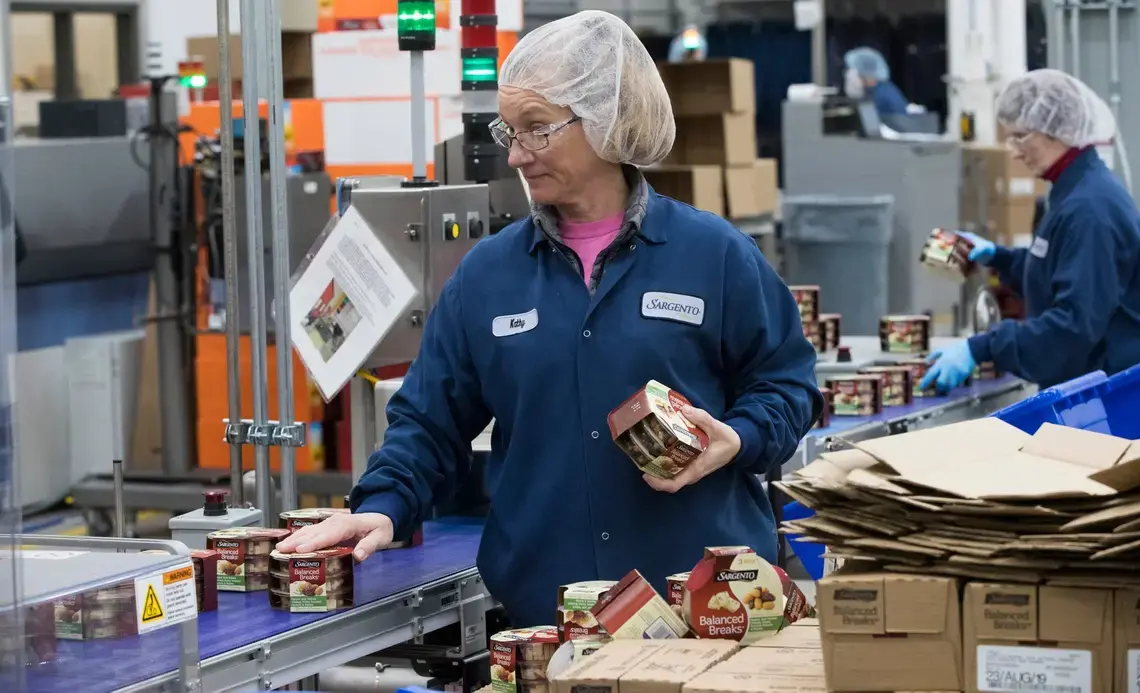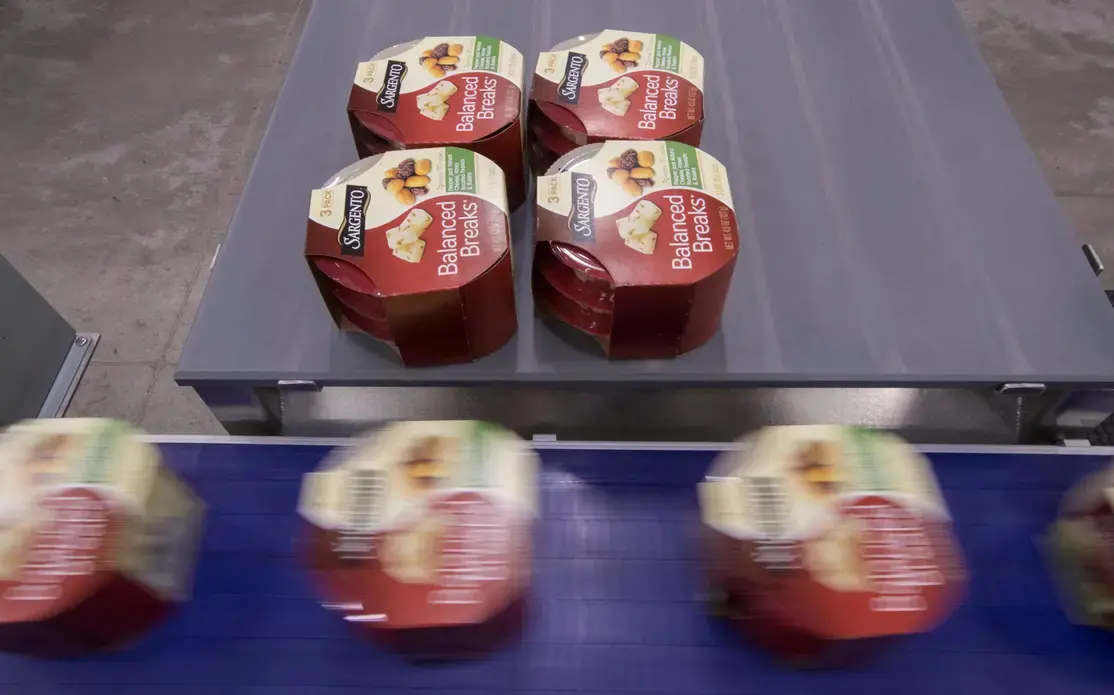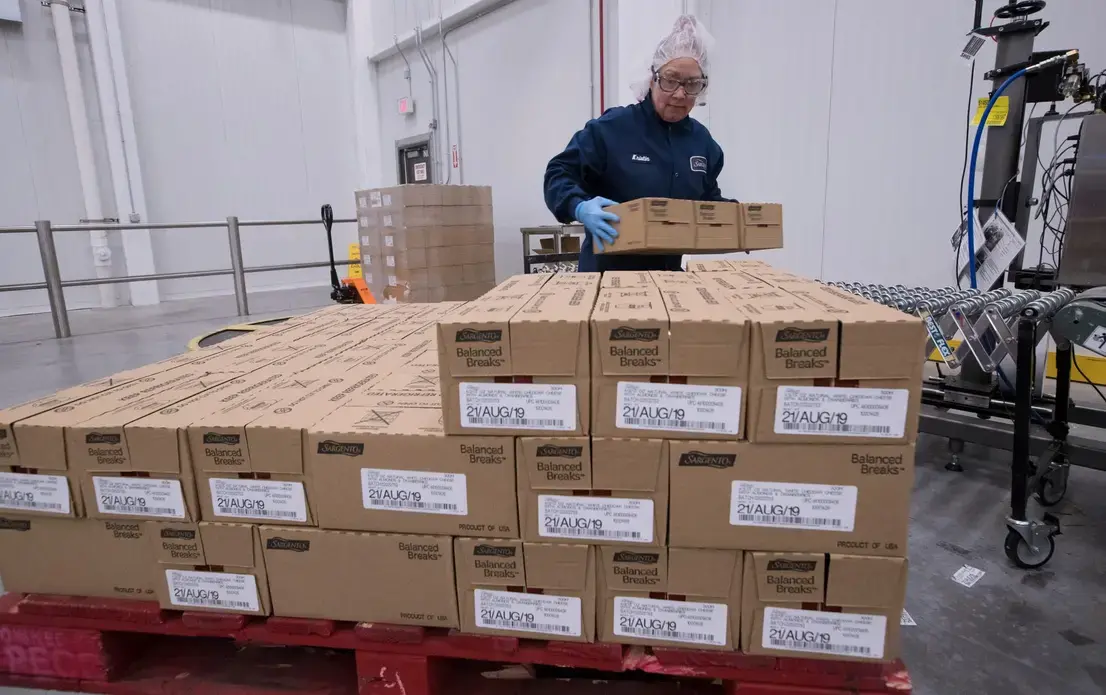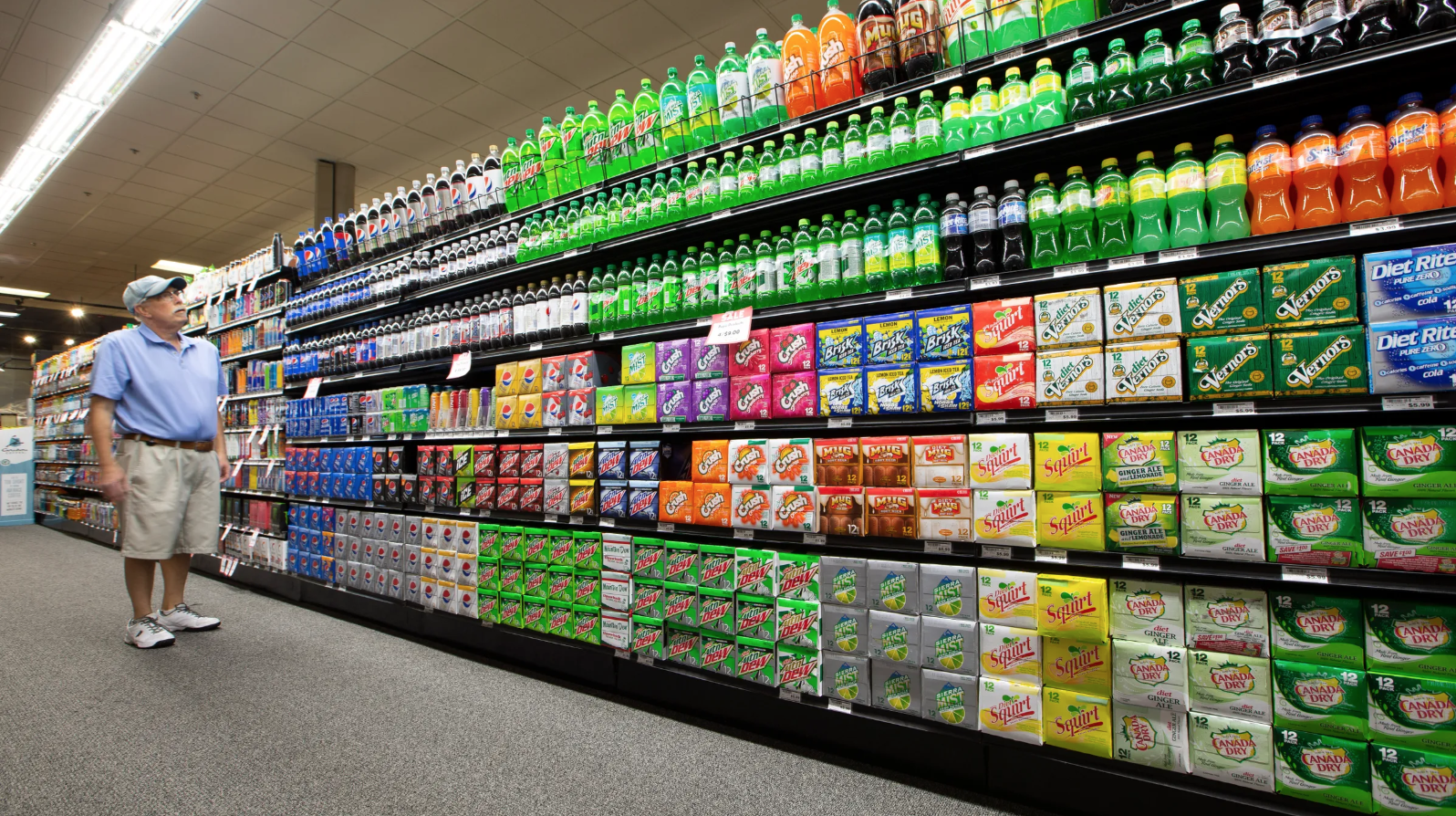
The advertising slogan first appeared in 1993, followed two years later by creamy white mustaches on celebrities’ upper lips. For the next two decades, “Got Milk?” commercials were a staple of pop culture.
The campaign captured multiple awards, branched out with Spanish and chocolate milk versions and ultimately featured about 300 big names in entertainment, media and sports. At one point, it was recognized by nine out of 10 Americans.
So, did more people actually get milk? No.
Other than a short-lived turnaround in a few markets, such as California, overall consumption of milk as a beverage failed to rise during a single year of the national campaign, which came to a close in 2014.
In fact, it's barely risen once since 1985, according to U.S. Department of Agriculture data.
Today, the dairy industry is undergoing seismic change, and the percentage of farms shutting down — especially small, family operations — is higher than at any time since the Great Depression.
In the first half of the year, 449 dairy farms were lost in Wisconsin alone, nearly 25% more than during the first six months of 2018 — a year that saw the loss of two farms a day.
Much of the blame has been placed on collapsed milk prices fueled by runaway production and trade wars that have soured export markets.
But another factor has been intractable: Milk isn't as popular as it used to be.
Drink Your Milk, It's Good for You
A century ago, declining milk consumption would have been hard to comprehend.
By the 1920s, the days of selling milk contaminated with dangerous bacteria, diluted with water and then laced with plaster dust to restore color, were ending. Pasteurization and refrigeration made milk much safer, and parents considered it the perfect drink for fast-growing children.
For the next half-century, milk trucks traced the streets of America, bringing fresh bottles to doorsteps daily the same way paperboys delivered newspapers and mail carriers brought letters and packages. About 30% of milk sold was still delivered to homes in the 1960s, according to USDA surveys.
In 1946, the National School Lunch Act mandated that any student receiving a subsidized lunch get the equivalent of a cup of whole milk, giving the dairy industry’s core product the endorsement of the government and, not incidentally, guaranteed sales.
"When I grew up, my mom poured a glass of milk at every meal and you were expected to drink it," said Mark Stephenson, director of dairy policy analysis at UW-Madison. "My mother would say, 'Drink your milk because it is good for you,' and scientists said 'It's good for you' and you believed them."
Milk’s preeminence began to wane a bit in the 1970s as the birthrate declined and nutritionists questioned the amount of fat in American diets. In 1977, the first edition of The Dietary Goals for the United States recommended lowering fat intake to reduce the incidence of coronary artery disease, diabetes, stroke and early mortality.
In 1985, the U.S. Department of Agriculture recommended low-fat dairy. Some consumers stopped buying milk entirely. Others switched to skim milk and other low-fat dairy products but found they lacked flavor and creaminess.
Families trying to improve their diets didn't always get the desired results. Studies found that people consumed more food because it was low-calorie, defeating the purpose. In addition, products billed as low-fat often were high in sugar. Since 1971, the earliest year full data was available, childhood obesity alone has risen more than 230%.
"While they were well-intended, the U.S. low-fat guidelines made in 1977 caused an overhaul of both the food industry and the average American’s perception of a healthy diet, eventually contributing to an overall decline in health ... rather than the anticipated opposite result," said a University of Connecticut study in 2016.
Another hit came in the 1990s when a national controversy erupted over the practice of injecting dairy cows with rBGH — recombinant bovine growth hormone. The synthetic hormone was used by farmers to increase milk production 10% to 25%. It became the highest-selling pharmaceutical in the history of the dairy industry.
The U.S. Food and Drug Administration approved rBGH as safe in 1993, and the dairy industry tried to reassure consumers that science couldn't detect any difference in the milk from rBGH-treated cows.
But research from the University of Wisconsin-Madison found that three out of four consumers had concerns about possible long-term health effects of drinking milk from rBGH-treated cows and 94% believed it should carry a special label.
Today, rBGH has nearly disappeared from dairy farms, and fats are split into good and bad categories.
"Consumers are not averse to dairy," said Jen Walsh, vice president of insights and strategy with the industry group Dairy Farmers of Wisconsin. "More than 90% of households have milk in the fridge right now."
Still, a typical American today drinks about 40% less milk than in the 1970s. Even the tradition of starting the day with cereal and milk has waned.
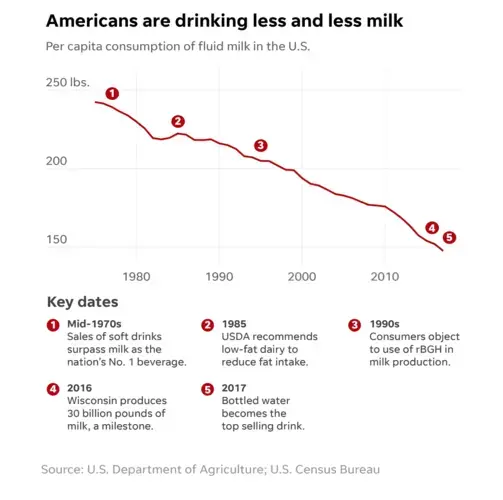
Relentless Competition
As diets changed, milk faced a tidal wave of new competitors.
Beverage companies, seeking to please a multitude of palates, flooded the market with sports drinks, energy drinks, plant-based sodas, fruit juices and designer coffees. A typical snack bar today might carry watermelon antioxidant infusion alongside mango and hibiscus herbal tea.
Just in the last half-dozen years, the average grocery store has added nearly 600 new beverage options to its coolers and shelves, according to Paul Ziemnisky, an executive vice president at Dairy Management Inc., a nonprofit funded by government-mandated payments from dairy farmers to promote milk products.
The primary nemesis has been even more elemental than milk itself: water.
"The truth is that more than half of milk’s lost volume went to bottled water — a product that didn’t hit the market until the late ’90s and has radically changed the beverage market ever since,” Walsh said.
Other competition has come from non-dairy drinks with "milk" in their name. Soy. Almond. Cashew. Coconut. Rice. Flax. Even hemp. Sales of those plant-based products grew 61% from 2012 to 2017.
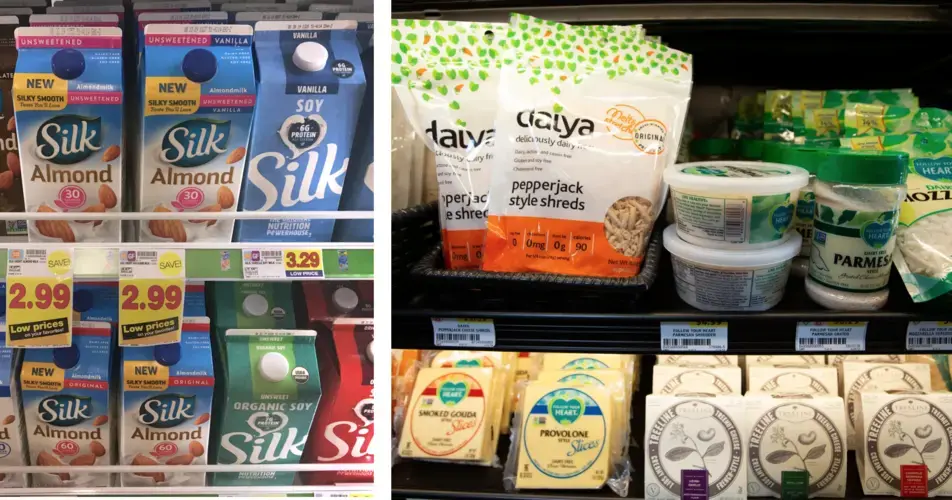
"In 2007, soy was nearly our only offering in the plant-based (beverage) category," said James J. Hyland, vice president of public affairs for Roundy’s Supermarkets Inc. "Almond milk now dominates the category in terms of selection and dollar sales, overtaking soy around 2011."
In March, U.S. Sen. Tammy Baldwin, D-Wis., reintroduced legislation to prevent plant-based drinks from being labeled as milk. The Dairy Pride Act would require the FDA to issue guidance for nationwide enforcement of mislabeled imitation dairy products and report to Congress in two years on its progress.
“Imitation products have gotten away with using dairy’s good name for their own benefit,” Baldwin said. “Mislabeling of plant-based products as milk hurts our dairy farmers.”
Supporters of the Dairy Pride Act say some consumers mistakenly equate the nutritional value of flaxseed milk or almond milk with cow's milk. They say crushed nuts or seeds mixed in water are no substitute for genuine milk. They also say the issue has significant public health implications because imitation dairy products lack consistent nutritional standards.
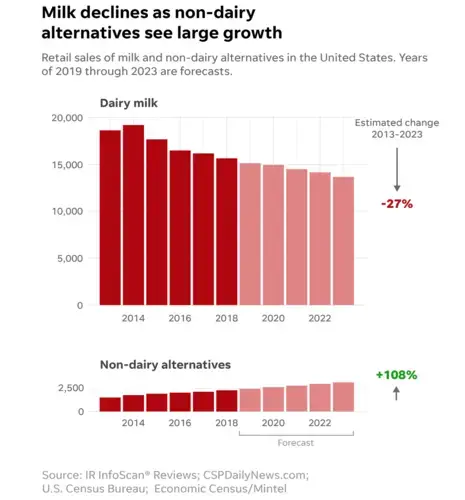
Critics of the proposed law say it's more about propping up the dairy industry than looking out for consumers.
"Tragically, the dairy lobby is avoiding their industry's real economic troubles of overproduction, consolidation ... and a lack of innovation," said Michele Simon, executive director of the Plant Based Foods Association, which represents more than 130 companies. "It may be easier to blame their troubles on the plant-based foods industry, but it's a disingenuous distraction from real issues and a disservice to dairy farmers."
The Butter Wars
This isn’t the first time the industry has faced a non-dairy opponent. Oleomargarine, as it was known, arrived in the United States in the 1870s and stirred up enough anxiety that farmers lobbied government officials for help. In 1886, the federal Margarine Act slapped prohibitive licenses and fees on manufacturers. Six states, including Wisconsin, went further, banning oleomargarine sales altogether.
“I want butter that has the natural aroma of life and health," said U.S. Sen. Joseph Quarles of Wisconsin. "I decline to accept as a substitute caul fat, matured under the chill of death, blended with vegetable oils and flavored by chemical tricks.”
By 1902, more than 30 states had forced color restrictions on oleomargarine, which is white, preventing manufacturers from adding yellow to make it look more like butter. Vermont, New Hampshire and South Dakota demanded that margarine be dyed pink, just to ensure it would be unpalatable.
Nevertheless, with the butter shortages of World War II, oleomargarine continued its inexorable climb. Some Wisconsinites drove across state lines to get margarine because it was cheaper than butter and, at least to some, tasted just as good. “Oleo smugglers,” as they were called, lined up at gas stations in northern Illinois and Iowa for boxes of the forbidden product — much like bootleggers loading up moonshine.\
“My earliest memories would be my father telling the neighbors that he was making a trip to Fossland, Illinois, just across the border,” said Fred Keller of Germantown. “The little penny-pincher women would want — and could afford — only three pounds of the good oleo, not the cheap stuff, and so it would go.”
The cheap stuff was oleo that came with a yellow dye packet that had to be mixed in. “It was a big, messy job,” Keller recalled. “My father wanted the mid-priced, or better, already-colored-yellow oleo."
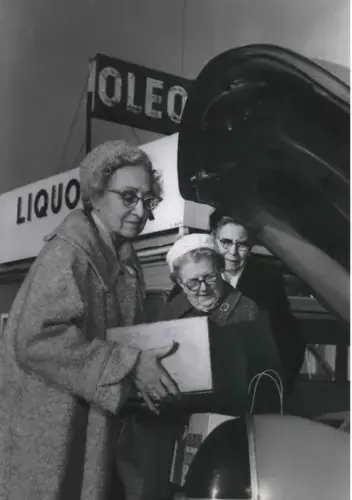
Eventually, all the state margarine laws were overturned. Wisconsin was the last holdout. But at least one remnant of the state's margarine laws remains. Restaurants in Wisconsin cannot serve margarine as a substitute for butter unless it is ordered by the customer. The penalty: Up to a $500 fine and three months in jail for the first offense; up to a year in jail for subsequent offenses.
A Bright Spot: Cheese
Amid the grim trends in milk consumption, cheese has acted as something of a safety net for dairy farmers, especially in Wisconsin. Over the past 30 years, cheese production in the state has ramped up 80%, or 1.5 billion pounds, according to Dairy Farmers of Wisconsin. Today, the state leads the U.S. in cheese production and makes more than most nations.
In 2018, Wisconsin dairy farms cranked out more than 30 billion pounds of milk (second to California) with 90% of it used to make 3.42 billion pounds of cheese. If Wisconsin were its own nation, it would rank fourth in cheese production behind the United States (including Wisconsin), Germany and France.
Wisconsin produces about 26% of the nation's cheese and also leads in the production of specialty cheeses such as Asiago, Gouda, Gorgonzola, aged Cheddar and Limburger. At $45 billion in annual sales, Wisconsin's dairy industry dwarfs citrus from Florida ($9 billion) and potatoes from Idaho ($6.7 billion).
While fresh milk is highly perishable and must be consumed within about a week, cheese can remain in storage for years — purposefully for aging or to wait for a better price. What's more, it typically takes 10 pounds of milk to create a pound of cheese, a plus for dairy farmers as year after year they have increased milk production and must find markets for what they've produced.
In 2009, there were 65 categories in the United States Championship Cheese Contest. This year, judges spent a day in the Lambeau Field Atrium in Green Bay sniffing and tasting 2,555 products in 116 categories, the latest in a string of record-breaking years for entries and categories.
Through innovation, the most successful cheesemakers have catered to convenience as well as taste.
Paolo Sartori, co-founder of the Plymouth, Wisconsin, cheese company that bears his last name, received a U.S. patent for a cheese curd machine in 1942 and then in 1946 received a patent for a curd mixing and kneading machine.
In 1953, nearby Sargento Foods offered the first precut cheese. In 1955, it introduced vacuum packages and three years later became the first company to market shredded cheese. The innovation has continued: resealable packages, cheese blends, low-fat and low-sodium options.
In 2015, Sargento rolled out Balanced Breaks — a snack pack of cheese, nuts and fruit — in four varieties. Eventually, a sweet line was introduced, then a breakfast line. The number of choices today: 18.
Other cheesemakers have developed niche specialties.
Baker Cheese Inc., founded in 1916 and headquartered in St. Cloud, Wisconsin, could have invested in new equipment a half-century ago and tried to compete with Sargento, Kraft and others in the shredded cheese market. At the time, it was largely producing blocks of mozzarella.
At a crossroads, the company went all-in on a product that at the time was just a small part of its business. According to family lore, Francis Baker recognized a market for smaller, individual-sized pieces of cheese, so he stretched out a ball of mozzarella into a thin rope and cut it into small segments. Today, Baker produces nearly 3 million string cheese sticks daily.
Marieke Penterman, who grew up in Holland and lived for a time in Canada, began making Gouda on her Thorp, Wisconsin, family farm in 2006.
“When I started making this, I remember my neighbor saying, ‘What is Gouda?’ So, I had to explain first what Gouda was," Penterman said. "Then the second question was ‘But Marieke, do we have enough Dutch people in this area that will eat it?' "
She explained to her neighbor that he didn't have to be Dutch to like Gouda.
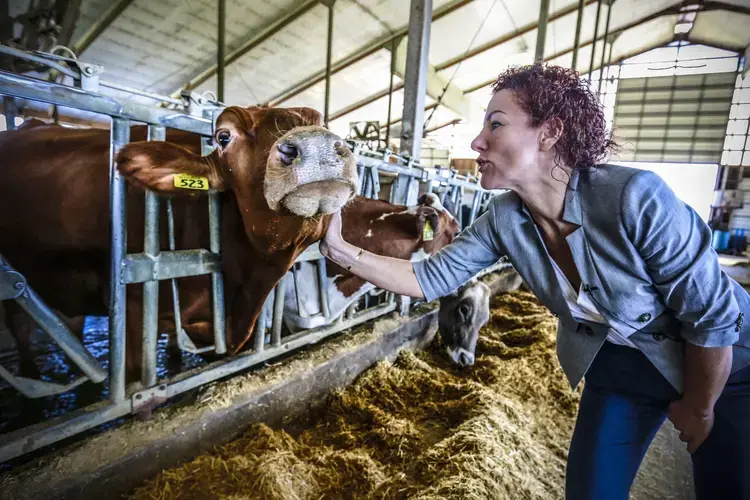
Penterman’s Gouda went on to win a best of class gold medal at the U.S. Championship Contest in 2007. In 2011, she was second runner-up for best in show, and two years later she won best of show. In 2019, two of her Goudas placed in the top three overall cheeses.
The Penterman farm has 400 cows and about 30% of the milk is made into Gouda. The cheesemaking operation is a separate business, but it gives the farm stability during extended periods of low milk prices.
“It helps our farm. It's a little insurance,” Penterman said.
Too Much Cheese
Even with robust cheese sales, there's too much of it stuffed in warehouses.
Last summer, the U.S. Department of Agriculture said almost 1.4 billion pounds was in refrigerated storage around the country. That's almost the combined weight of eight U.S. Navy aircraft carriers.
By June this year, cheese in cold storage was down 7 million pounds compared to a year ago, according to USDA records. That's the first such dip since October 2014, but it is still higher than at any point since a peak in the early 1980s.
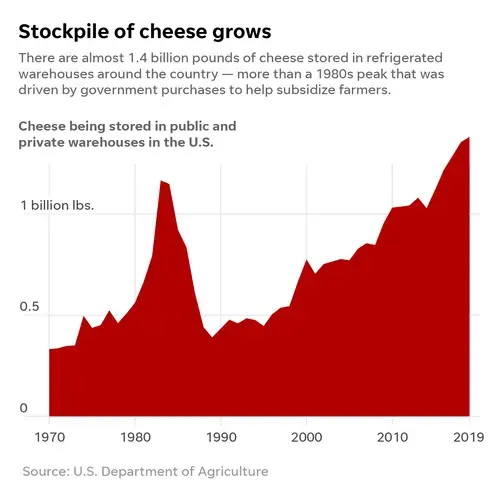
That glut of cheese in the ’80s was brought on by overproduction of milk, which was fueled by billions of dollars in government subsidies to farmers. The government bought the excess cheese and was stuck with a massive stockpile it had no easy way to unload.
"Probably the cheapest and most practical thing to do would be to dump it in the ocean," one USDA official told the Washington Post in 1981.
Instead, under President Ronald Reagan, the government launched a program that gave away 5-pound blocks of processed cheese to low-income people, the elderly and social service organizations.
The program lasted into the 1990s, when the amount of cheese in storage fell below 500 million pounds and the milk supply and farmers' milk prices stabilized.
Now, the stockpiles have mushroomed again.
If nothing else, it's been a boon to storage companies.
When Stan Dietsche started working at Oshkosh Cold Storage in 1994, the company had one 40,000-square-foot facility. The company continued to expand in Oshkosh and about five years ago built a 220,000-square-foot warehouse in Plymouth. That site has since doubled in size. Today, total storage space at the two locations has increased to nearly 20 million cubic feet. It’s almost exclusively used for cheese.
Joe Hall opened KJ Cold Storage this year in Muscoda, a small rural community in southwest Wisconsin. Hall owns a dairy transportation company and began planning the storage business four years ago. He anticipates filling the 49,000-square-foot warehouse by October, mostly with dairy products.
"It is pretty much impossible to know, from the USDA data, what amount is cheese that is in storage on purpose and what is there because you couldn’t find a buyer," said Andrew Novakovic, an agricultural economics professor at Cornell University.
However, with most of Wisconsin's milk turned into cheese, dairy farmers and the economy depend on it ultimately finding a home.
“There is no state for which the cheese sector is more important than Wisconsin," Novakovic said. "That is simply a given."
Yogurt Sales Help. A Little.
Another bright spot — of sorts — for the industry has been yogurt sales.
In 1990, the average American consumed 3.9 pounds of yogurt. That had risen to nearly 15 pounds by 2014, before slipping to 13.7 pounds in 2017.
The drawback: It takes about 10 pounds of milk to make one pound of cheese, while it takes only a pound of milk to make a pound of yogurt, meaning dairy farmers don't benefit as much. What's more, experts say the yogurt segment of the market has matured.
Darren Seifer, a food and beverage industry analyst with The NPD Group, a market research firm, said lack of innovation has been partially to blame.
"By 2010, nothing new was coming out in the yogurt segment," he said, adding that yogurt began to lose its newfound seat at the breakfast table. "Eggs made a comeback because we’re not as concerned about fats."
In addition, like milk, yogurt is facing plant-based competition. Danone North America, which sells Dannon yogurt, recently announced a line of oat-milk yogurt alternatives under its Silk brand which helped fuel the nation's craving for soy milk back in the late 1970s.
Plant-based products with butter as part of their name also have gained a foothold in the marketplace.
The government should put an end to "vegan shenanigans" before federal standards of identity for dairy products become meaningless, said Tom Balmer, executive director of the American Butter Institute, a dairy industry trade group.
An Uncertain Future
Critics of the dairy industry say it lost sight of consumer tastes and instead put too much emphasis on boosting bovine genetics to get more milk per cow.
"It's in trouble because it has focused on cows instead of consumers," said Hank Cardello, a senior fellow at the Hudson Institute and director of its Obesity Solutions Initiatives.
"Having been in the soft drinks business, I was there when we surpassed milk as the No. 1 beverage," he said. "It should have been their wake-up call."
That milestone came more than 40 years ago.
Lately, there's been a flurry of activity with milk that is laser-focused on health benefits.
Organic Valley, a La Farge, Wisconsin-based cooperative with more than 2,000 farm members in 34 states, recently launched an "ultrafiltered" organic milk that claims to have 50% more protein, 45% more calcium and 50% less sugar than regular milk. And it's lactose-free.
The cooperative, which had more than $1 billion in sales in 2018 but still operated at a loss, has pushed the boundary with milk, including a variety with fish oil added that aims to capitalize on omega-3 fatty acid's association with brain health.
There's also “A-2” milk. It's like conventional milk but doesn't have an “A-1” beta-casein protein, which studies have said makes milk less digestible for some people.
Flavored-milk sales have gone up, so expect flavors beyond chocolate and strawberry to hit the market in the next year or two. Think cherry cordial.
And consumers could see more non-refrigerated dairy products.
The Center for Dairy Research at UW-Madison recently received grants to work with companies developing shelf-stable milk products, such as ready-to-drink coffee with creamer or milk-based workout recovery drinks. With a longer expiration date, these products could be shipped overseas.
Cardello of the Hudson Institute said milk could yet make a comeback.
"I've seen enough brands reverse their course to say it's never too late," he said. "And milk still has a wholesomeness to it that you don't find in most products."
Like crop farmers who diversify what gets planted, some players in the dairy industry have hedged their bets on beverages.
In 2016, New York City's last legacy dairy, which once delivered milk in trucks filled with blocks of ice, called it quits — only to reopen as a plant-based beverage maker. It wasn't an easy decision for Elmhurst 1925, named after the year it was founded. But on its website, Elmhurst noted "more and more people were eating healthier, adopting plant-based alternatives."
Dean Foods, one of the nation's largest dairy companies, a year ago bought a majority stake in Good Karma Foods, a Boulder, Colorado, maker of flaxseed milk.
In labeling its dairy-alternative products, Good Karma uses terms such as milk and yogurt — even though Dean Foods says it's against such claims.
Dairy Farmers of America, a national milk cooperative that is the largest supplier of farm milk in the world, now owns Stremicks Heritage Foods, a California-based maker of 8th Continent Soymilk, which is marketed as the "perfect choice on breakfast cereal or as a milk substitute."
Kim O'Brien, spokeswoman for Dairy Farmers of America, said the Stremicks labels are being updated.
When they are, she said, 8th Continent packaging will no longer say "milk."




